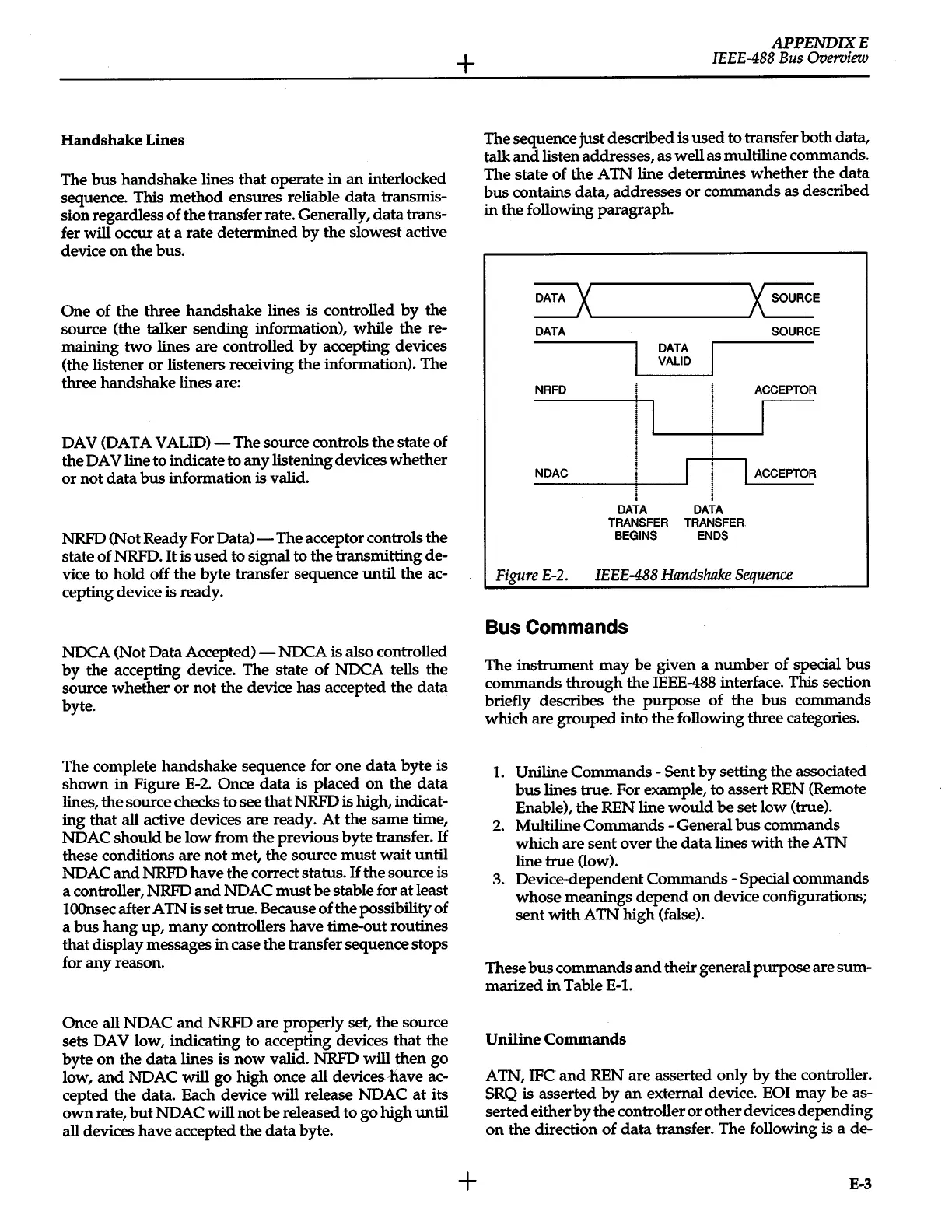Handshake
Lines
The
bus
handshake lines that operate
in
an
interlocked
sequence.
This
method ensures reliable data transmis-
sion regardless of the transfer rate. Generally, data trans-
fer will occur
at
a rate determined
by
the slowest active
device on the bus.
One of the three handshake lines is controlled
by
the
source (the talker sending information), while the re-
maining two lines are controlled
by
accepting devices
(the listener
or
listeners receiving the information). The
three handshake lines are:
DAV (DATA
VAUD)-
The source controls the state of
the DA
V line to indicate to any listening devices whether
or
not data bus information is valid.
NRFD (Not Ready For
Data)-
The acceptor controls the
state of NRFD.
It
is used to signal to the transmitting de-
vice to hold off the byte transfer sequence until the ac-
cepting device is ready.
NDCA (Not Data
Accepted)-
NDCA is also controlled
by
the accepting device. The state
of
NDCA tells the
source whether
or
not the device has accepted the data
byte.
The complete handshake sequence for one data byte is
shown
in
Figure
E-2.
Once data is placed
on
the data
lines, the source checks to see that NRFD is high, indicat-
ing that all active devices are ready.
At
the same time,
NDAC should be low from the previous byte transfer.
If
these conditions are
not
met, the source
must
wait until
NDAC
and
NRFD have the correct status.
If
the source is
a controller, NRFD
and
NDAC
must
be stable for
at
least
lOOnsec
after ATN is set true. Because of the possibility of
a bus hang up, many controllers have time-out routines
that display messages
in
case the transfer sequence stops
for any reason.
Once all NDAC
and
NRFD are properly set, the source
sets DA V
low, indicating
to accepting devices that the
byte on the data lines is
now
valid. NRFD will then go
low,
and
NDAC
will
go high once all
devices"have ac-
cepted the data. Each device
will
release NDAC
at
its
own rate,
but
NDAC
will
not
be released to go high until
all devices have accepted the data byte.
+
+
APPENDIXE
IEEE-488
Bus
Overview
The sequence just described is used to transfer both data,
talk
and
listen addresses, as well as multiline commands.
The state of the ATN line determines whether the data
bus
contains data, addresses
or
commands as described
in
the following paragraph.
~--------....Jx
SOURCE
DATA
SOURCE
NRFD
DATA
VALID
ACCEPTOR
NDAC
I
ACCEPTOR
DATA DATA
TRANSFER
TRANSFER
BEGINS
ENDS
Figure
E-2.
IEEE-488
Handshake
Sequence
Bus
Commands
The instrument
may
be given a number of special bus
commands through the
IEEE-488
interface.
This
section
briefly describes the purpose of the
bus
commands
which are grouped into the following three categories.
1.
Uniline
Commands - Sent
by
setting the associated
bus
lines true. For example, to assert REN (Remote
Enable), the REN line would be set low (true).
2.
Multiline
Commands-
General bus commands
which are sent over the data lines with the ATN
line true (low).
3.
Device-dependent
Commands-
Special
commands
whose meanings depend
on
device configurations;
sent with ATN high (false).
These
bus
commands
and
their general purpose are sum-
marized
in
Table
E-1.
Uniline
Commands
ATN, IFC
and
REN are asserted only
by
the controller.
SRQ
is asserted
by
an
external device. EOI
may be as-
serted either
by
the controller
or
other devices depending
on
the direction of data transfer. The following is a de-
E-3
